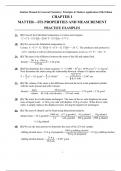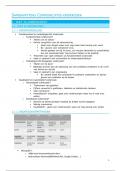Solution Manual for General Chemistry: Principles & Modern Applications 10th Edition
CHAPTER 1
MATTER—ITS PROPERTIES AND MEASUREMENT
PRACTICE EXAMPLES
1A (E) Convert the Fahrenheit temperature to Celsius and compare.
C = F 32 F 59 CF = 350 F 32 F 59 CF = 177 C .
1B (E) We convert the Fahrenheit temperature to
Celsius. C = F 32 F 59 CF = 15 F 32 F 5 C
9 F
= 26 C . The antifreeze only protects to
22 C and thus it will not offer protection to temperatures as low as 15 F = 26.1 C .
2A (E) The mass is the difference between the mass of the full and empty flask.
291.4 g 108.6 g
density = = 1.46 g/mL
125 mL
2B (E) First determine the volume required. V = (1.000 × 103 g) (8.96 g cm-3) = 111.6 cm3.
Next determine the radius using the relationship between volume of a sphere and radius.
4 3 4 111.6 3
V= r = 111.6 cm3 = (3.1416)r3 r= 3 = 2.987 cm
3 3 4(3.1416)
3A (E) The volume of the stone is the difference between the level in the graduated cylinder
with the stone present and with it absent.
mass 28.4 g rock
density = = = 2.76 g/mL = 2.76 g/cm3
volume 44.1 mL rock &water 33.8 mL water
3B (E) The water level will remain unchanged. The mass of the ice cube displaces the same
mass of liquid water. A 10.0 g ice cube will displace 10.0 g of water. When the ice cube
melts, it simply replaces the displaced water, leaving the liquid level unchanged.
4A (E) The mass of ethanol can be found using dimensional analysis.
1000 mL 0.71 g gasohol 10 g ethanol 1 kg ethanol
ethanol mass = 25 L gasohol
1L 1 mL gasohol 100 g gasohol 1000 g ethanol
= 1.8 kg ethanol
4B (E) We use the mass percent to determine the mass of the 25.0 mL sample.
100.0 g rubbing alcohol
rubbing alcohol mass = 15.0 g (2-propanol) = 21.43 g rubbing alcohol
70.0 g (2-propanol)
21.4 g
rubbing alcohol density = = 0.857 g/mL
25.0 mL
1
,Chapter 1: Matter – Its Properties and Measurement
5A (M) For this calculation, the value 0.000456 has the least precision (three significant
figures), thus the final answer must also be quoted to three significant figures.
62.356
= 21.3
0.000456 6.422 103
5B (M) For this calculation, the value 1.3 10 3 has the least precision (two significant
figures), thus the final answer must also be quoted to two significant figures.
8.21 104 1.3 10 3
2
= 1.1 106
0.00236 4.071 10
6A (M) The number in the calculation that has the least precision is 102.1 (+0.1), thus the final
answer must be quoted to just one decimal place. 0.236 +128.55 102.1 = 26.7
6B (M) This is easier to visualize if the numbers are not in scientific notation.
1.302 103 + 952.7 1302 + 952.7 2255
= = = 15.6
1.57 102 12.22 157 12.22 145
INTEGRATIVE EXAMPLE
A (D) Stepwise Approach: First, determine the density of the alloy by the oil displacement.
Mass of oil displaced = Mass of alloy in air – Mass of alloy in oil
= 211.5 g – 135.3 g = 76.2 g
VOil = m / D = 76.2 g / 0.926 g/mL = 82.3 mL = VMg-Al
DMg-Al = 211.5 g / 82.3 mL = 2.57 g/cc
Now, since the density is a linear function of the composition,
DMg-Al = mx + b, where x is the mass fraction of Mg, and b is the y-intercept.
Substituting 0 for x (no Al in the alloy), everything is Mg and the equation becomes:
1.74 = m · 0 + b. Therefore, b = 1.74
Assuming 1 for x (100% by weight Al):
2.70 = (m × 1) + 1.74, therefore, m = 0.96
Therefore, for an alloy:
2.57 = 0.96x + 1.74
x = 0.86 = mass % of Al
Mass % of Mg = 1 – 0.86 = 0.14, 14%
2
, Chapter 1: Matter – Its Properties and Measurement
B (M) Stepwise approach:
Mass of seawater = D • V = 1.027 g/mL × 1500 mL = 1540.5 g
2.67 g NaCl 39.34 g Na
1540.5 g seawater = 16.18 g Na
100 g seawater 100 g NaCl
Then, convert mass of Na to atoms of Na
1 kg Na 1 Na atom
16.18 g Na = 4.239 1023 Na atoms
1000 g Na 3.817 10 26 kg Na
Conversion Pathway:
2.67 g NaCl 39.34 g Na 1 kg Na 1 Na atom
1540.5 g seawater
100 g seawater 100 g NaCl 1000 g Na 3.8175 10 26 kg Na
EXERCISES
The Scientific Method
1. (E) One theory is preferred over another if it can correctly predict a wider range of
phenomena and if it has fewer assumptions.
2. (E) No. The greater the number of experiments that conform to the predictions of the law,
the more confidence we have in the law. There is no point at which the law is ever verified
with absolute certainty.
3. (E) For a given set of conditions, a cause, is expected to produce a certain result or effect.
Although these cause-and-effect relationships may be difficult to unravel at times (“God is
subtle”), they nevertheless do exist (“He is not malicious”).
4. (E) As opposed to scientific laws, legislative laws are voted on by people and thus are subject
to the whims and desires of the electorate. Legislative laws can be revoked by a grass roots
majority, whereas scientific laws can only be modified if they do not account for experimental
observations. As well, legislative laws are imposed on people, who are expected to modify
their behaviors, whereas, scientific laws cannot be imposed on nature, nor will nature change to
suit a particular scientific law that is proposed.
5. (E) The experiment should be carefully set up so as to create a controlled situation in
which one can make careful observations after altering the experimental parameters,
preferably one at a time. The results must be reproducible (to within experimental error)
and, as more and more experiments are conducted, a pattern should begin to emerge, from
which a comparison to the current theory can be made.
3
, Chapter 1: Matter – Its Properties and Measurement
6. (E) For a theory to be considered as plausible, it must, first and foremost, agree with
and/or predict the results from controlled experiments. It should also involve the fewest
number of assumptions (i.e., follow Occam’s Razor). The best theories predict new
phenomena that are subsequently observed after the appropriate experiments have been
performed.
Properties and Classification of Matter
7. (E) When an object displays a physical property it retains its basic chemical identity. By
contrast, the display of a chemical property is accompanied by a change in composition.
(a) Physical: The iron nail is not changed in any significant way when it is attracted to a
magnet. Its basic chemical identity is unchanged.
(b) Chemical: The paper is converted to ash, CO2(g), and H2O(g) along with the
evolution of considerable energy.
(c) Chemical: The green patina is the result of the combination of water, oxygen, and
carbon dioxide with the copper in the bronze to produce basic copper carbonate.
(d) Physical: Neither the block of wood nor the water has changed its identity.
8. (E) When an object displays a physical property it retains its basic chemical identity. By
contrast, the display of a chemical property is accompanied by a change in composition.
(a) Chemical: The change in the color of the apple indicates that a new substance
(oxidized apple) has formed by reaction with air.
(b) Physical: The marble slab is not changed into another substance by feeling it.
(c) Physical: The sapphire retains its identity as it displays its color.
(d) Chemical: After firing, the properties of the clay have changed from soft and pliable
to rigid and brittle. New substances have formed. (Many of the changes involve
driving off water and slightly melting the silicates that remain. These molten
substances cool and harden when removed from the kiln.)
9. (E) (a) Homogeneous mixture: Air is a mixture of nitrogen, oxygen, argon, and traces of
other gases. By “fresh,” we mean no particles of smoke, pollen, etc., are present.
Such species would produce a heterogeneous mixture.
(b) Heterogeneous mixture: A silver plated spoon has a surface coating of the element
silver and an underlying baser metal (typically iron). This would make the coated
spoon a heterogeneous mixture.
(c) Heterogeneous mixture: Garlic salt is simply garlic powder mixed with table salt.
Pieces of garlic can be distinguished from those of salt by careful examination.
(d) Substance: Ice is simply solid water (assuming no air bubbles).
4





